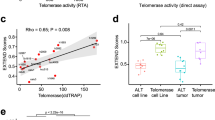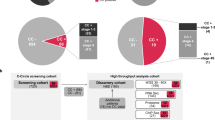Abstract
Telomere length is maintained by two known mechanisms, the activation of telomerase or alternative lengthening of telomeres (ALT). The molecular mechanisms regulating the ALT phenotype are poorly understood and it is unknown how the decision of which pathway to activate is made at the cellular level. We have shown earlier that active repression of telomerase gene expression by chromatin remodelling of the promoters is one mechanism of regulation; however, other genes and signalling networks are likely to be required to regulate telomerase and maintain the ALT phenotype. Using gene expression profiling, we have uncovered a signature of 1305 genes to distinguish telomerase-positive and ALT cell lines. By combining this with the gene expression profiles of liposarcoma tissue samples, we refined this signature to 297 genes. A network analysis of known interactions between genes within this signature revealed a regulatory signalling network consistent with a model of human telomerase reverse transcriptase (hTERT) repression in ALT cell lines and liposarcomas. This network expands on our existing knowledge of hTERT regulation and provides a platform to understand differential regulation of hTERT in different tumour types and normal tissues. We also show evidence to suggest a novel mesenchymal stem cell origin for ALT immortalization in cell lines and mesenchymal tissues.
This is a preview of subscription content, access via your institution
Access options
Subscribe to this journal
Receive 50 print issues and online access
$259.00 per year
only $5.18 per issue
Buy this article
- Purchase on Springer Link
- Instant access to full article PDF
Prices may be subject to local taxes which are calculated during checkout





Similar content being viewed by others
Accession codes
References
Atkinson SP, Hoare SF, Glasspool RM, Keith WN . (2005). Lack of telomerase gene expression in alternative lengthening of telomere cells is associated with chromatin remodeling of the hTR and hTERT gene promoters. Cancer Res 65: 7585–7590.
Bernardo ME, Zaffaroni N, Novara F, Cometa AM, Avanzini MA, Moretta A et al. (2007). Human bone marrow derived mesenchymal stem cells do not undergo transformation after long-term in vitro culture and do not exhibit telomere maintenance mechanisms. Cancer Res 67: 9142–9149.
Bryan TM, Englezou A, Dalla-Pozza L, Dunham MA, Reddel RR . (1997). Evidence for an alternative mechanism for maintaining telomere length in human tumors and tumor-derived cell lines. Nat Med 3: 1271–1274.
Cairney CJ, Hoare SF, Daidone MG, Zaffaroni N, Keith WN . (2008). High level of telomerase RNA gene expression is associated with chromatin modification, the ALT phenotype and poor prognosis in liposarcoma. Br J Cancer 98: 1467–1474.
Cairney CJ, Keith WN . (2008). Telomerase redefined: integrated regulation of hTR and hTERT for telomere maintenance and telomerase activity. Biochimie 90: 13–23.
Chen YJ, Hakin-Smith V, Teo M, Xinarianos GE, Jellinek DA, Carroll T et al. (2006). Association of mutant TP53 with alternative lengthening of telomeres and favorable prognosis in glioma. Cancer Res 66: 6473–6476.
Costa A, Daidone MG, Daprai L, Villa R, Cantu S, Pilotti S et al. (2006). Telomere maintenance mechanisms in liposarcomas: association with histologic subtypes and disease progression. Cancer Res 66: 8918–8924.
Gibbs CP, Kukekov VG, Reith JD, Tchigrinova O, Suslov ON, Scott EW et al. (2005). Stem-like cells in bone sarcomas: implications for tumorigenesis. Neoplasia 7: 967–976.
Hakin-Smith V, Jellinek DA, Levy D, Carroll T, Teo M, Timperley WR et al. (2003). Alternative lengthening of telomeres and survival in patients with glioblastoma multiforme. Lancet 361: 836–838.
Hao H, Nancai Y, Lei F, Xiong W, Wen S, Guofu H et al. (2008). siRNA directed against c-Myc inhibits proliferation and downregulates human telomerase reverse transcriptase in human colon cancer Colo 320 cells. J Exp Clin Cancer Res 27: 27.
Henson JD, Hannay JA, McCarthy SW, Royds JA, Yeager TR, Robinson RA et al. (2005). A robust assay for alternative lengthening of telomeres in tumors shows the significance of alternative lengthening of telomeres in sarcomas and astrocytomas. Clin Cancer Res 11: 217–225.
Henson JD, Neumann AA, Yeager TR, Reddel RR . (2002). Alternative lengthening of telomeres in mammalian cells. Oncogene 21: 598–610.
Huang PR, Tsai ST, Hsieh KH, Wang TC . (2008). Heterogeneous nuclear ribonucleoprotein A3 binds single-stranded telomeric DNA and inhibits telomerase extension in vitro. Biochim Biophys Acta 1783: 193–202.
Jiang WQ, Zhong ZH, Henson JD, Reddel RR . (2007). Identification of candidate alternative lengthening of telomeres genes by methionine restriction and RNA interference. Oncogene 26: 4635–4647.
Johnson JE, Varkonyi RJ, Schwalm J, Cragle R, Klein-Szanto A, Patchefsky A et al. (2005). Multiple mechanisms of telomere maintenance exist in liposarcomas. Clin Cancer Res 11: 5347–5355.
Matushansky I, Hernando E, Socci ND, Mills JE, Matos TA, Edgar MA et al. (2007). Derivation of sarcomas from mesenchymal stem cells via inactivation of the Wnt pathway. J Clin Invest 117: 3248–3257.
Mehle C, Piatyszek MA, Ljungberg B, Shay JW, Roos G . (1996). Telomerase activity in human renal cell carcinoma. Oncogene 13: 161–166.
Miura M, Miura Y, Padilla-Nash HM, Molinolo AA, Fu B, Patel V et al. (2006). Accumulated chromosomal instability in murine bone marrow mesenchymal stem cells leads to malignant transformation. Stem Cells 24: 1095–1103.
Riggi N, Suva ML, Suva D, Cironi L, Provero P, Tercier S et al. (2008). EWS-FLI-1 expression triggers a Ewing's sarcoma initiation program in primary human mesenchymal stem cells. Cancer Res 68: 2176–2185.
Rubio D, Garcia-Castro J, Martin MC, de la Fuente R, Cigudosa JC, Lloyd AC et al. (2005). Spontaneous human adult stem cell transformation. Cancer Res 65: 3035–3039.
Serakinci N, Guldberg P, Burns JS, Abdallah B, Schrodder H, Jensen T et al. (2004). Adult human mesenchymal stem cell as a target for neoplastic transformation. Oncogene 23: 5095–5098.
Serakinci N, Hoare SF, Kassem M, Atkinson SP, Keith WN . (2006). Telomerase promoter reprogramming and interaction with general transcription factors in the human mesenchymal stem cell. Regen Med 1: 125–131.
Tirode F, Laud-Duval K, Prieur A, Delorme B, Charbord P, Delattre O . (2007). Mesenchymal stem cell features of Ewing tumors. Cancer Cell 11: 421–429.
Ulaner GA, Hoffman AR, Otero J, Huang HY, Zhao Z, Mazumdar M et al. (2004). Divergent patterns of telomere maintenance mechanisms among human sarcomas: sharply contrasting prevalence of the alternative lengthening of telomeres mechanism in Ewing's sarcomas and osteosarcomas. Genes Chromosomes Cancer 41: 155–162.
Ulaner GA, Huang HY, Otero J, Zhao Z, Ben-Porat L, Satagopan JM et al. (2003). Absence of a telomere maintenance mechanism as a favorable prognostic factor in patients with osteosarcoma. Cancer Res 63: 1759–1763.
Wang Y, Huso DL, Harrington J, Kellner J, Jeong DK, Turney J et al. (2005). Outgrowth of a transformed cell population derived from normal human BM mesenchymal stem cell culture. Cytotherapy 7: 509–519.
Wu C, Wei Q, Utomo V, Nadesan P, Whetstone H, Kandel R et al. (2007). Side population cells isolated from mesenchymal neoplasms have tumor initiating potential. Cancer Res 67: 8216–8222.
Yeager TR, Neumann AA, Englezou A, Huschtscha LI, Noble JR, Reddel RR . (1999). Telomerase-negative immortalized human cells contain a novel type of promyelocytic leukemia (PML) body. Cancer Res 59: 4175–4179.
Zhao YM, Li JY, Lan JP, Lai XY, Luo Y, Sun J et al. (2008). Cell cycle dependent telomere regulation by telomerase in human bone marrow mesenchymal stem cells. Biochem Biophys Res Commun 369: 1114–1119.
Zhong ZH, Jiang WQ, Cesare AJ, Neumann AA, Wadhwa R, Reddel RR . (2007). Disruption of telomere maintenance by depletion of the MRE11/RAD50/NBS1 complex in cells that use alternative lengthening of telomeres. J Biol Chem 282: 29314–29322.
Zhou YF, Bosch-Marce M, Okuyama H, Krishnamachary B, Kimura H, Zhang L et al. (2006). Spontaneous transformation of cultured mouse bone marrow-derived stromal cells. Cancer Res 66: 10849–10854.
Zimmermann S, Voss M, Kaiser S, Kapp U, Waller CF, Martens UM . (2003). Lack of telomerase activity in human mesenchymal stem cells. Leukemia 17: 1146–1149.
Acknowledgements
This work was supported by the Cancer Research UK, European Community Grants LSHC-CT-2004-502943, LSHC-CT-2005-0018806 and Health-F2-2007-200950 Glasgow University and Italian Association for Cancer Research.
Author information
Authors and Affiliations
Corresponding author
Rights and permissions
About this article
Cite this article
Lafferty-Whyte, K., Cairney, C., Will, M. et al. A gene expression signature classifying telomerase and ALT immortalization reveals an hTERT regulatory network and suggests a mesenchymal stem cell origin for ALT. Oncogene 28, 3765–3774 (2009). https://doi.org/10.1038/onc.2009.238
Received:
Revised:
Accepted:
Published:
Issue Date:
DOI: https://doi.org/10.1038/onc.2009.238
Keywords
This article is cited by
-
Subcellular progression of mesenchymal transition identified by two discrete synchronous cell lines derived from the same glioblastoma
Cellular and Molecular Life Sciences (2022)
-
Functional characterization of miR-708 microRNA in telomerase positive and negative human cancer cells
Scientific Reports (2021)
-
Integrated analysis of telomerase enzymatic activity unravels an association with cancer stemness and proliferation
Nature Communications (2021)
-
Analysis of two mechanisms of telomere maintenance based on the theory of g-Networks and stochastic automata networks
BMC Genomics (2020)
-
The non-canonical functions of telomerase: to turn off or not to turn off
Molecular Biology Reports (2019)



